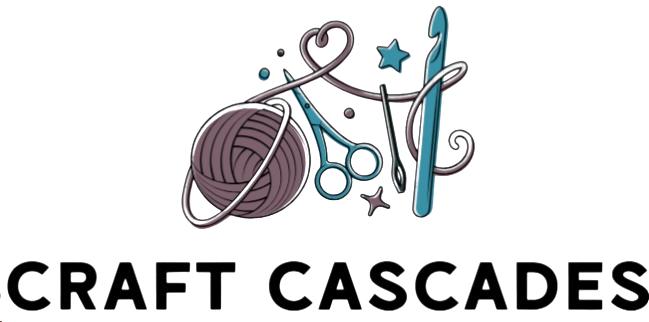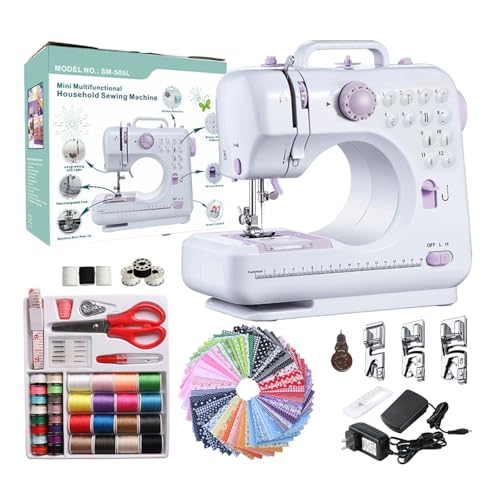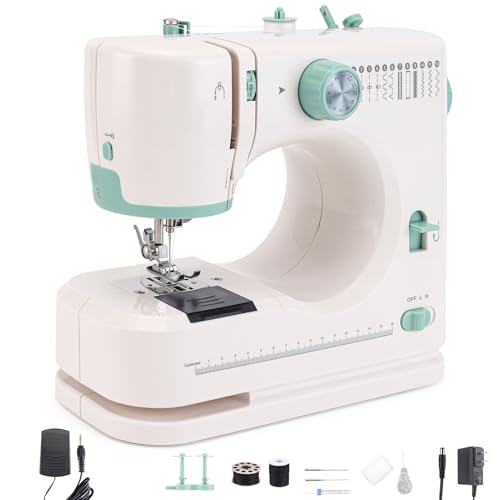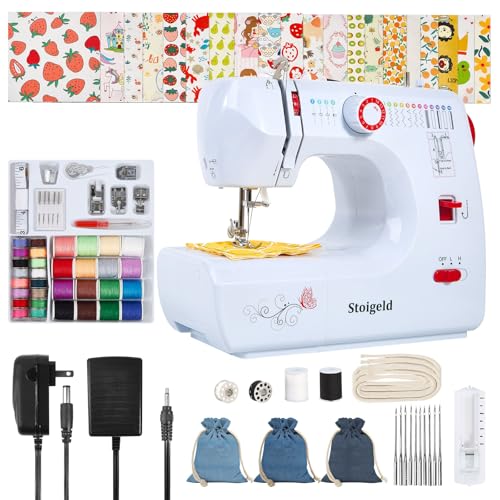Recent market research shows that 73% of home sewists struggle to find a sewing machine that includes all the essential parts they need. Whether you’re starting your first project or upgrading your current setup, choosing the right machine with proper accessories can mean the difference between frustration and success. You’ll uncover how the top seven machines of 2026 stack up against each other, along with essential insights about their included parts and performance capabilities.
Singer All Purpose Sewing Machine Oil, 3.38-Fluid Ounce
Singer’s All Purpose Sewing Machine Oil stands out as a versatile lubricant that extends beyond its primary sewing machine application. You’ll find it effective on locks, bicycles, fans, and door hinges, reducing noise by up to 90%. This 3.38-fluid-ounce bottle has earned a stellar 4.8-star rating from over 5,400 customers.
Since its release in November 2020, it’s claimed the #1 spot in the Sewing Machine Oil category and ranks #467 in Arts, Crafts & Sewing. While some users note it’s pricey for the quantity, its exceptional performance on household appliances from hair shavers to garage doors makes it a worthwhile investment.
Best For: DIY enthusiasts and homeowners looking for a high-quality, versatile lubricant that works effectively on sewing machines and various household mechanical items like door hinges, locks, and small appliances.
Pros:
- Exceptional noise reduction capability (up to 90%)
- Versatile application across multiple household items and machinery
- High customer satisfaction with 4.8/5 stars from over 5,400 reviews
Cons:
- Relatively expensive for the quantity provided
- Small bottle size (3.38 oz) may require frequent repurchasing
- Some users may find the packaging design makes precise application challenging
Portable Mini Electric Sewing Machine with 12 Built-in Stitches
For novice sewers seeking an entry-level machine, this portable mini electric sewing machine offers the perfect blend of simplicity and functionality. You’ll find 12 built-in stitches and dual power options, letting you choose between an AC adapter or battery operation. At just 4.2 pounds, it’s lightweight and compact enough for easy storage.
The machine comes with helpful threading guides and includes a 50-piece fabric bundle and 32-piece thread kit to get you started. While customer ratings average 3.6 stars, with some concerns about quality control, it’s a practical choice for basic projects and alterations. Remember to watch the instructional videos before use and avoid using both power modes simultaneously.
Best For: Beginners, children, and casual sewers looking for a lightweight, portable machine for basic sewing projects and simple alterations.
Pros:
- Lightweight and portable design at only 4.2 pounds
- Comes with comprehensive starter kit including fabrics and threads
- Versatile power options with both AC adapter and battery operation
Cons:
- Quality control issues reported by some customers
- Limited functionality compared to full-size machines
- Mixed customer reviews with average 3.6-star rating
WINB Portable Sewing & Quilting Machine with 12 Built-in Stitches
The WINB Portable Sewing & Quilting Machine packs remarkable versatility into a compact 3-pound frame, making it an ideal choice for beginners and casual hobbyists.
You’ll appreciate the user-friendly features like the 3-second auto needle threader and laser-etched guides that simplify operation. The 12 built-in stitches cover basic, stretch, decorative, and buttonhole options, while the extra-large 6.5-inch workspace handles bulky fabrics with ease.
The machine’s two-speed control and free-arm design let you tackle everything from simple mending to quilting projects. While it’s not meant for heavy-duty tasks, its portability and beginner-friendly controls make it perfect for learning and light sewing work.
Best For: Beginner sewists and casual hobbyists looking for a lightweight, portable machine for basic sewing projects and light quilting work.
Pros:
- Lightweight and portable at just 3 pounds
- User-friendly features including auto needle threader and clear guides
- Versatile with 12 built-in stitches and free-arm capability
Cons:
- Not suitable for heavy-duty sewing tasks
- Limited workspace dimensions of 1 x 1 x 1 inches
- Potential difficulty finding replacement parts
Stainless Steel Bobbin Case for Front Loading Sewing Machines
Selecting the right bobbin case can make or break your sewing experience, and Mudder’s stainless steel bobbin case delivers exceptional value for front-loading machine owners. You’ll get four cases in each package, perfect for replacements or sharing with fellow sewists.
These 22.75mm cases fit most popular brands, including Brother, Singer, and Janome. They’re designed to stop spinning quickly, preventing thread tangles during operation. While they’ve earned a strong 4.5-star rating from over 3,600 users, keep in mind they might not match the precision of original parts. However, at this price point, you’re getting durable stainless steel construction and reliable performance for your front-loading 15 class machine.
Best For: Home sewists with front-loading 15 class machines who want affordable backup bobbin cases or need to replace worn originals.
Pros:
- Comes in a value pack of four stainless steel cases
- Compatible with multiple popular sewing machine brands
- Quick-stopping design prevents thread tangling
Cons:
- May not match the precision of original manufacturer parts
- Some users report inconsistent quality between cases
- Limited to front-loading machines only
Universal Zigzag Presser Foot for Domestic Sewing Machines
Experienced sewists and beginners alike will appreciate the versatility of this universal zigzag presser foot, designed to fit most low-shank domestic sewing machines. You’ll find it compatible with major brands like Brother, Janome, and Singer, featuring an 8mm zigzag opening that’s perfect for various stitch styles.
This STORMSHOPPING Foot-33 model excels at straight stitching, decorative work, and elastic insertion. Its quick-clicking system means you won’t need tools to attach or remove it. At just 0.317 ounces and measuring 1.57 x 0.87 x 0.87 inches, it’s a compact yet essential addition to your sewing arsenal. With a 4.7-star rating from 385 reviews, it’s proven reliable for everyday sewing tasks.
Best For: Home sewists of all skill levels seeking a versatile presser foot that works with multiple stitch types and fits most low-shank domestic sewing machines.
Pros:
- Universal compatibility with many popular sewing machine brands
- Tool-free installation and removal with quick-clicking system
- Versatile 8mm opening suitable for multiple stitch types including straight, zigzag, and decorative
Cons:
- Only compatible with low-shank machines
- May not work with some specialty or industrial machines
- Limited to 8mm maximum stitch width
4 Pieces Singer Sewing Machine Spool Pin Caps (511113-456)
Sewing enthusiasts seeking reliable thread management will find these Singer spool pin caps indispensable. These plastic caps fit 1/4-inch pins and are compatible with Singer’s 2000, 4000, 5000, 6000, and 9000 series machines. You’ll get four durable caps that prevent thread from jumping while you sew.
With an outside diameter of 1 3/4 inches, they’re designed to fit numerous models, including the popular 1482, 2102, and 4205 series. They’ve earned a solid 4.4-star rating from users, proving their effectiveness in keeping thread properly positioned during your sewing projects. The lightweight design and sturdy construction guarantee they won’t break or deform with regular use.
Best For: Sewists who own Singer machines in the 2000-9000 series and need reliable thread management solutions for smooth, uninterrupted sewing sessions.
Pros:
- Compatible with a wide range of Singer sewing machine models
- Comes in a set of 4 caps for multiple machine setups or replacements
- Durable plastic construction that resists deformation
Cons:
- Limited to 1/4 inch pin size compatibility
- May not fit some older or newer Singer models outside specified series
- Plastic material may not be as premium as original equipment parts
Portable Sewing Machine with 16 Built-in Stitches and Accessories Kit
Beginners looking for their first sewing machine will find this portable model hits all the right marks. With 16 built-in stitches and two speed settings, you’ll have plenty of options for basic projects. The machine’s easy-thread guides and pre-loaded bobbins help you get started quickly.
At just 7.3 pounds, you can easily move this compact machine around your workspace. You’ll get everything needed to start sewing immediately, including 20 fabric sheets, three drawstring bag kits, and 32 threads. The extensive 42-piece accessory kit provides zippers, presser feet, and spare needles. If issues arise, you’re covered with 24/7 customer support and a satisfaction guarantee.
Best For: Beginner sewers and crafters seeking an affordable, portable machine for basic projects like hemming, repairs, and simple DIY crafts.
Pros:
- Comprehensive starter kit includes everything needed to begin sewing immediately
- Lightweight and compact design makes it easy to store and transport
- User-friendly features like easy-thread guides and pre-loaded bobbins simplify setup
Cons:
- Limited to light and medium-weight fabrics only
- Only two speed settings may restrict more advanced projects
- Small size may not be suitable for large quilting or heavy-duty sewing tasks
Factors to Consider When Choosing a Sewing Machine With Parts
When you’re shopping for a sewing machine, you’ll need to evaluate key features like the number of built-in stitches and whether the machine’s weight and dimensions suit your workspace. You should also check the power requirements and included accessories to verify they match your needs and budget. Make certain replacement parts are readily available from the manufacturer or authorized dealers to keep your machine running smoothly for years to come.
Built-in Stitch Options
The versatility of built-in stitch options plays a crucial role in your sewing machine’s functionality. Most machines offer between 12 to 16 different stitches, including straight, zigzag, and decorative patterns that’ll cover your essential sewing needs.
When you’re shopping for a machine, you’ll find that beginner-friendly models feature preset settings and visual guides, making stitch selection straightforward. These built-in options let you tackle various techniques like hemming, quilting, and appliqué without needing extra attachments. If you’re looking at portable machines, they typically include fundamental stitches for basic customization.
For more advanced projects, consider machines with reverse sewing functions and complex stitch patterns. These premium features help you achieve professional-quality finishes and expand your creative possibilities.
Machine Weight and Size
Every sewing machine’s weight and size greatly impact its functionality and convenience. If you’re looking for portability, choose a lightweight model between 4-7 pounds, which you’ll find ideal for travel and compact spaces. However, remember that heavier machines exceeding 10 pounds offer better stability and durability during intensive sewing projects.
Consider your workspace dimensions when selecting a machine. Compact models measuring 5-12 inches in width and height are perfect for limited spaces and easy storage. While larger machines provide more features and capabilities, they’ll require dedicated setup areas. As a beginner, you might prefer a lightweight, compact machine for simpler projects and easier handling. Just keep in mind that lighter machines may struggle with heavy fabrics, so match the machine’s specifications to your intended use.
Power Source Requirements
Understanding your sewing machine’s power source requirements will considerably impact its versatility and functionality. You’ll need to decide between AC-powered, battery-operated, or dual-power machines based on where and how you’ll use your equipment.
Dual-power machines offer the best flexibility, letting you switch between AC adapters for home use and batteries for on-the-go sewing. However, if you choose a battery-operated option, remember you’ll likely need to purchase batteries separately, adding to your initial investment.
Check the machine’s wattage and energy consumption carefully. Higher-powered models might not work well in locations with limited electrical supply. The power source you select will also affect your machine’s motor performance and durability, especially if you’re planning lengthy sewing sessions.
Included Accessory Packages
Most sewing machines come with accessory packages that greatly affect their versatility and value. When you’re shopping for a machine, take time to review the included accessories, as they’ll enhance your sewing capabilities and save you money on additional purchases.
Look for packages that offer essential items like bobbins, needles, various presser feet, and compatible thread kits. For beginners, machines that include pre-cut fabric sheets and instructional materials are particularly valuable. These resources can help you start sewing immediately and learn proper techniques through included tutorials.
You’ll want to ascertain the accessory package matches your intended projects. Whether you’re planning to work with different fabrics or try various sewing techniques, having the right tools included with your machine will make your sewing experience more enjoyable and productive.
Maintenance Part Availability
When shopping for a sewing machine, you’ll need to carefully evaluate the availability of maintenance parts to confirm your investment stays operational for years to come. Focus on machines that offer easy access to essential components like bobbin cases and presser feet, which you’ll regularly need to maintain or replace.
Check if replacement parts, particularly stainless steel bobbin cases for front-loading machines, are readily available from multiple suppliers. You’ll want to determine that presser feet are compatible across various brands, especially if you have a low-shank machine. This compatibility gives you more options for future upgrades and replacements.
Before making your final decision, review customer feedback about parts availability and research the manufacturer’s warranty and return policies. This confirms you’ll have support if replacement parts don’t meet your expectations.
Threading System Design
A well-designed threading system can make the difference between frustration and enjoyment in your sewing projects. When evaluating threading systems, you’ll want to look for machines with clear, marked threading paths and automatic needle threaders that simplify the process.
Look for models featuring laser-etched guides that make it easy to follow the threading path. You’ll also benefit from a reverse stitching function, which helps you lock stitches securely while threading. The best systems can handle various thread types and fabrics without compromising performance.
Pay close attention to the tension control mechanisms, as they’re essential for preventing thread jams and ensuring consistent stitch quality. A properly designed threading system won’t just save you time – it’ll help you achieve professional-looking results across all your sewing projects.
Fabric Handling Capabilities
Since every sewing project demands different fabric handling requirements, your machine’s ability to work with various materials can make or break your success. You’ll want a machine that can smoothly shift from delicate cotton to heavy denim without compromising stitch quality.
Look for adjustable presser foot pressure settings that’ll help you maintain control over different fabric thicknesses. A free arm feature will make it easier to work with sleeves and cuffs, while diverse stitch options guarantee you’re equipped for any material type. Consider the machine’s weight carefully – lighter models offer portability, but heavier ones provide better stability when working with thick fabrics. The best machines offer versatility through multiple stitch settings, letting you switch between zigzag stitches for stretchy fabrics and straight stitches for basic seams.
Cost Versus Features
Making smart decisions about cost versus features requires careful consideration of both your immediate budget and long-term sewing goals. You’ll want to evaluate machines based on their built-in stitches and accessories that directly align with your projects.
While premium models might seem expensive initially, they often prove more economical over time through superior durability and lower maintenance costs. When comparing prices, focus on machines with high customer ratings and readily available replacement parts. Don’t just count features – assess their practical value for your needs.
Remember that a machine’s true cost extends beyond the purchase price. You’ll need to factor in the availability and price of compatible accessories and replacement components. A moderately priced machine with reliable parts accessibility might serve you better than a feature-rich model with limited support.








